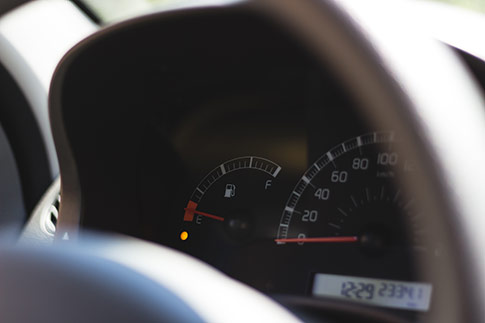When the low-fuel warning light comes on, how much farther can you drive?

If your car engine reaches its fuel reserve, what distance can you drive until you’re “running on fumes?” We have the answer for the most popular vehicles in North America, and a few tips to stop the worst from happening.
Once the warning light comes on, there is usually about 10 litres (2.6 U.S. gallons) of fuel left in the tank. In other words, with some exceptions (Korean-made models, for example), most vehicles can go another approximately 90 to 130 kilometres before the engine sputters and dies, forcing the driver to walk all the way to the nearest gas station or call a roadside assistance service.
Three factors that influence fuel consumption
While it’s useful to know how many litres your fuel tank contains, you shouldn’t put too much stock in the numbers once the low-fuel indicator kicks on, just as you shouldn’t rely on your instrument cluster’s “kilometres remaining” display: these readings are approximate.
Fuel economy is anything but an infallible science. It is influenced by multiple factors:
- Driving style. Heavy on the gas pedal obviously equals heavy on gas.
- Type of route. City driving uses more fuel than highway driving.
- Weather conditions. Tires biting into snow mean up to one-third greater fuel consumption than tires rolling on dry pavement.
Avoid running out of fuel and damaging your vehicle
What’s the best way to avoid the stress of running out of gas, having to call for a tow, putting your life or that of others in danger, or having to pay for costly repairs? It’s simple: “Make sure your fuel gauge reads at least one-quarter full at all times,” says Sylvain Légaré, a research analyst with CAA-Quebec Automotive Advisory Services.
Our mechanics expert reminds readers that driving near empty can damage vehicle components, starting with the fuel pump: “To work properly, the pump needs to be lubricated by the fuel itself,” cautions Mr. Légaré.
Moreover, the bottom of your fuel tank contains contaminants and debris that you don’t want transferred to the car’s other components. If you’re running near empty, your catalytic converter is vulnerable to damage from an improper air-fuel mixture. Once in a while won’t kill it, but repeated occurrences could well cause this emission control component to exact revenge—on your wallet.
In addition, Mr. Légaré concludes, “with our yo-yo-ing weather conditions and temperatures below zero almost six months a year in Quebec, there’s the danger that gas or condensation in the tank or fuel line will freeze if the tank isn’t sufficiently filled.”
If you own an electric vehicle, you should take similar precautions. Don’t wait until the available battery power gets too low, as this can make recharging more difficult. Forewarned is forearmed!
